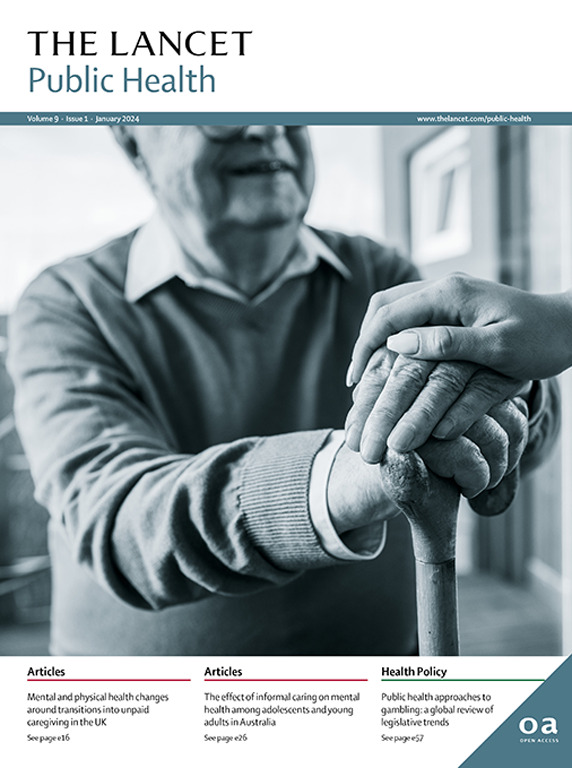比较加拿大安大略省处方阿片类药物更安全供应和美沙酮的影响:基于人群的匹配队列研究
IF 25.4
1区 医学
Q1 PUBLIC, ENVIRONMENTAL & OCCUPATIONAL HEALTH
引用次数: 0
摘要
处方更安全阿片类药物供应(SOS)规划是一种新型的减少危害干预措施。我们检查了接受SOS治疗的人群在一段时间内的健康状况,并与接受美沙酮治疗的人群进行了比较。方法:我们对加拿大安大略省2016年1月1日至2021年12月31日期间开始接受SOS和美沙酮治疗的新患者进行了一项基于人群的队列研究。根据年龄(3年内)、性别、居住地(公共卫生单位)和倾向评分(0.2 sd内)将接受SOS治疗的人与新接受美沙酮治疗的人进行1:1的匹配。主要结局是住院治疗的阿片类药物相关毒性、急诊科就诊和住院、意外感染和1年随访期间的医疗保健费用(以加元计算,不包括与初级保健服务和药物相关的费用)。计算随访期间的转成率,并对死亡、SOS或美沙酮停用或随访结束(360天)进行审查。使用中断时间序列分析评估组内结果的变化,并使用Prentice-Williams-Peterson回归评估复发事件的组间差异。结果991名新接受SOS治疗者和25116名符合资格标准的美沙酮新接受者中,856名(86.4%)接受SOS治疗者与856名接受美沙酮治疗者相匹配。在组内分析中,匹配的SOS受者在阿片类药物毒性的月发生率方面有显着改善(每100个人的阶跃变化为- 1.09事件[95% CI - 2.12至- 0.07];P = 0.037),全因急诊科就诊(- 8.85 /人/年[- 13.5 ~ - 4.20];P = 0.0002)、全因住院人数(- 2.08 /人/年[- 3.41至- 0.75];P = 0.0022),事件感染(- 0.68 /人/年[- 0.22 ~ - 0.14];P = 0.013),非初级保健相关的保健费用(每人年- 91 699美元[- 112 749至- 70 650];术;0·0001)。美沙酮接受者的结果一致。在组间分析中,开始SOS治疗的个体发生阿片类药物毒性的风险(风险比2.83 [95% CI 1.97 ~ 4.06])、急诊科就诊率(1.16[1.05 ~ 1.29])和住院率(1.50[1.13 ~ 1.99])显著高于开始使用美沙酮治疗的个体(0.62[0.55 ~ 0.70]),而感染发生率(1.51[0.87 ~ 2.61])差异无统计学意义。当停止治疗作为审查标准被删除时,我们发现各组之间除了阿片类药物毒性外,任何主要结局的危险都没有差异(1.65[1.38至1.97])。sos和美沙酮与健康结果的改善有关,包括治疗开始后一年内阿片类药物毒性和保健使用的减少。研究结果表明,SOS规划在扩大为吸毒者提供支持的选择方面,对传统阿片类激动剂治疗起着重要的补充作用。加拿大卫生研究所和安大略SPOR支助单位。本文章由计算机程序翻译,如有差异,请以英文原文为准。
Comparing the effects of prescribed safer opioid supply and methadone in Ontario, Canada: a population-based matched cohort study
Background
Prescribed safer opioid supply (SOS) programmes are novel harm reduction interventions. We examined health outcomes among people receiving SOS over time and relative to a similar group of people receiving methadone.Methods
We conducted a population-based cohort study among new SOS and methadone recipients in Ontario, Canada, who commenced treatment between Jan 1, 2016 and Dec 31, 2021. People receiving SOS were matched (1:1) to new methadone recipients based on age (within 3 years), sex, location of residence (public health unit), and propensity score (within 0·2 SDs). Primary outcomes were hospital-treated opioid-related toxicities, emergency department visits and inpatient hospitalisations, incident infections, and health-care costs (in CA$, excluding costs related to primary care services and medications) over 1 year of follow-up. Outcome rates were calculated over the follow-up period, with censoring on death, discontinuation of SOS or methadone, or end of follow-up (360 days). Within-group changes in outcomes were assessed using interrupted time-series analysis, and Prentice–Williams–Peterson regression was used to assess between-group differences in recurrent events.Findings
Of the 991 new recipients prescribed SOS and 25 116 new methadone recipients who met the eligibility criteria, 856 (86·4%) people receiving SOS were matched to 856 people receiving methadone. In the within-group analysis, matched SOS recipients had significant improvements in the monthly rate of opioid toxicities (step change –1·09 events per 100 individuals [95% CI –2·12 to –0·07]; p=0·037), all-cause emergency department visits (–8·85 per person-year [–13·5 to –4·20]; p=0·0002), all-cause inpatient hospitalisations (–2·08 per person-year [–3·41 to –0·75]; p=0·0022), incident infections (–0·68 per person-year [–1·22 to –0·14]; p=0·013), and non-primary-care-related health-care costs (–$91 699 per person-year [–112 749 to –70 650]; p<0·0001). Results were consistent for methadone recipients. In the between-group analysis, individuals commencing SOS had significantly higher hazards of opioid toxicity (hazard ratio 2·83 [95% CI 1·97 to 4·06]), emergency department visits (1·16 [1·05 to 1·29]), and inpatient admissions (1·50 [1·13 to 1·99]), no significant difference in the rate of incident infection (1·51 [0·87 to 2·61]), and were less likely to discontinue treatment than those commencing methadone (0·62 [0·55 to 0·70]). When treatment discontinuation was removed as a censoring criterion, we found no difference between groups in the hazard of any of the primary outcomes except opioid toxicity (1·65 [1·38 to 1·97]).Interpretation
SOS and methadone were associated with improvements in health outcomes, including reduced opioid toxicities and health-care use, in the year after treatment initiation. The findings suggest SOS programmes play an important, complementary role to traditional opioid agonist treatment in expanding the options available to support people who use drugs.Funding
Canadian Institutes of Health Research and Ontario SPOR Support Unit.求助全文
通过发布文献求助,成功后即可免费获取论文全文。
去求助
来源期刊

Lancet Public Health
Medicine-Public Health, Environmental and Occupational Health
CiteScore
55.60
自引率
0.80%
发文量
305
审稿时长
8 weeks
期刊介绍:
The Lancet Public Health is committed to tackling the most pressing issues across all aspects of public health. We have a strong commitment to using science to improve health equity and social justice. In line with the values and vision of The Lancet, we take a broad and inclusive approach to public health and are interested in interdisciplinary research.
We publish a range of content types that can advance public health policies and outcomes. These include Articles, Review, Comment, and Correspondence. Learn more about the types of papers we publish.
 求助内容:
求助内容: 应助结果提醒方式:
应助结果提醒方式:


